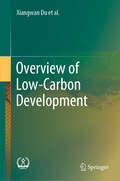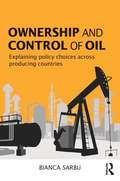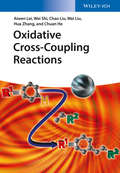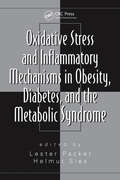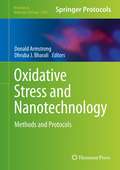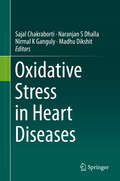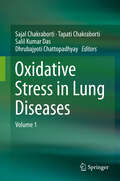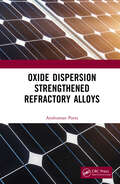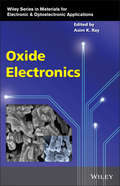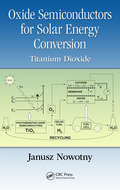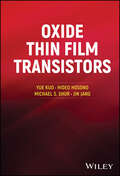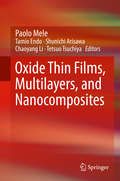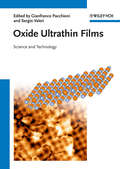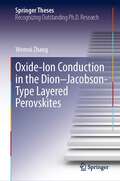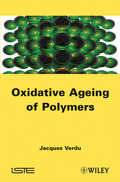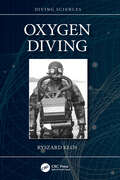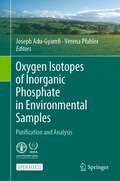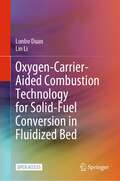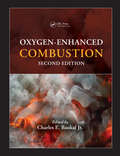- Table View
- List View
Overview of Low-Carbon Development
by Qiang Liu Xiangwan Du Dadi Zhou Qingchen Chao Zongguo Wen Taoli HuheThis book introduces readers to the status quo and recent advances in China’s low-carbon development. From the evolution of human civilization, to the proposal of low-carbon concepts, up to the choice of China’s low-carbon path, the book provides a comprehensive review of low-carbon development, while also elaborating on the core concept, goals and methods. In addition, it addresses a series of questions and issues closely tied to today’s social development, such as: “Why is it so vital to pursue low-carbon development?” and “How can China implement low-carbon development?” Accordingly, readers will gain a better grasp of low-carbon development, including low-carbon production and low-carbon lifestyles.
Own Your Tech Career: Soft skills for technologists
by Don JonesOwn Your Tech Career: Soft skills for technologists is a guide to taking control of your professional life. It teaches you to approach your career with planning and purpose, always making active decisions towards your goals.Summary In Own Your Tech Career: Soft skills for technologists, you will: Define what &“success&” means for your career Discover personal branding and career maintenance Prepare for and conduct a tech job hunt Spot speed bumps and barriers that can derail your progress Learn how to navigate the rules of the business world Perform market analysis to keep your tech skills fresh and relevant Whatever your road to success, you&’ll benefit from the toolbox of career-boosting techniques you&’ll find in Own Your Tech Career: Soft skills for technologists. You&’ll discover in-demand communication and teamwork skills, essential rules for professionalism, tactics of the modern job hunt, and more. Purchase of the print book includes a free eBook in PDF, Kindle, and ePub formats from Manning Publications. About the technology A successful technology career demands more than just technical ability. Achieving your goals requires clear communication, top-notch time management, and a knack for navigating business needs. Master the &“soft skills,&” and you&’ll have a smoother path to success and satisfaction, however you define that for yourself. About the book Own Your Tech Career: Soft skills for technologists helps you get what you want out of your technology career. You&’ll start by defining your ambition—whether that&’s a salary, a job title, a flexible schedule, or something else. Once you know where you&’re going, this book&’s adaptable advice guides your journey. You&’ll learn conflict resolution and teamwork, master nine rules of professionalism, and build the confidence and skill you need to stay on the path you&’ve set for yourself. What's inside Personal branding and career maintenance Barriers that derail progress The rules of the business world Market analysis to keep tech skills fresh About the reader For tech professionals who want to take control of their career. About the author Microsoft MVP Don Jones brings his years of experience as a successful IT trainer to this engaging guide. Table of Contents 1 Own your career 2 Build and maintain your brand 3 Network 4 Be part of a technology community 5 Keep your tech skills fresh and relevant 6 Show up as a professional 7 Manage your time 8 Handle remote work 9 Be a team player 10 Be a team leade 11 Solve problems 12 Conquer written communications 13 Conquer verbal communications 14 Resolve conflicts 15 Be a data-driven, critical thinker 16 Understand how businesses work 17 Be a better decision-maker 18 Help others 19 Be prepared for anything 20 Business math and terminology for technologists 21 Tools for the modern job hunt
Ownership and Control of Oil: Explaining Policy Choices across Producing Countries
by Bianca SarbuOwnership and Control of Oil examines government decisions about how much control to exert over the petroleum industry, focusing on the role of National Oil Companies in the production of crude oil since the nationalizations in the 1970s. What are the motives for which some producing states opt for less and NOT more control of their oil production sector? When can International Oil Companies enter the upstream industry of producing states and under what conditions? The diversity of policy choices across producers provides the stage for this investigation: different theoretical explanations are confronted, with the empirical evidence, with the aim of finally proposing an interdisciplinary framework of analysis to explain who controls oil production around the world. This book is intended for both specialists and general readers who have an interest in the issue of government control of the petroleum industry. Due to its multidisciplinary approach, the book is aimed at a large academic public composed of scholars of Political Science, International Political Economy, Comparative Politics, and Middle East Area Studies. Moreover, this book should be relevant to international consultants, industry professionals and decision-makers in countries assessing their experience with existing control structures as well as the many countries in the process of joining the ‘petroleum club’ of oil producing nations.
Oxen: A Teamster's Guide to Raising, Training, Driving & Showing
by Drew ConroyVersatile as well as powerful, oxen can plow fields, haul stones, assist in logging, and improve roads. This comprehensive guide covers all aspects of selecting, training, feeding, and caring for your oxen. You’ll learn how to fit yokes and bows, address common challenges, and maintain your team’s overall health. Whether you’re looking for an economical alternative to heavy machinery on the farm or want to compete at the next county fair, Drew Conroy will help you achieve success with your oxen.
Oxidative Cross-Coupling Reactions
by Wei Liu Aiwen Lei Wei Shi Chao Liu Hua Zhang Chuan HeThe first handbook on this emerging field provides a comprehensive overview of transition metal-catalyzed coupling reactions in the presence of an oxidant. Following an introduction to the general concept and mechanism of this reaction class, the team of authors presents chapters on C-C cross-coupling reactions using organometallic partners, C-Heteroatom bond forming reactions via oxidative couplings, and C-H couplings via C-H activation. The text also covers such groundbreaking topics as recent achievements in the fields of C-C and C-X bond formation reactions as well as C-H activation involving oxidative couplings. With its novel and concise approach towards important building blocks in organic chemistry and its focus on synthetic applications, this handbook is of great interest to all synthetic chemists in academia and industry alike.
Oxidative Stress and Inflammatory Mechanisms in Obesity, Diabetes, and the Metabolic Syndrome
by Helmut Sies Lester PackerCharacterized by obesity, insulin resistance, dyslipidemia, and hypertension, metabolic syndrome is associated with the risks of type 2 diabetes mellitus and cardiovascular disease. Obesity, which increases the incidence of atherosclerotic cardiovascular disease and subsequently leads to increased stress and inflammation, appears to play a central
Oxidative Stress and Nanotechnology
by Donald Armstrong Dhruba J BharaliThe emergence of nanotechnology has had a profound effect on almost every aspect of the 21st century's daily life. It has had a revolutionary impact from stain-resistant clothing and cosmetics to environmental issues , including energy and medicine and even aerospace engineering. In Oxidative Stress and Nanotechnology: Methods and Protocols, expert researchers in the field detail various aspects of nanotechnology from the oxidative stress point of view. Focusing on synthesis of different antioxidant nanoparticles and antioxidant-loaded nanoparticles, as well as their in vitro/ in vivo mechanisms of action along with their clinical relevance. Written in the highly successful Methods in Molecular BiologyTM series format, chapters include introductions to their respective topics, lists of the necessary materials and reagents, step-by-step, readily reproducible laboratory protocols, and key tips on troubleshooting and avoiding known pitfalls. Authoritative and practical, Oxidative Stress and Nanotechnology: Methods and Protocols seeks to aid scientists in the further study of techniques for nanotechnology in pathophysiology and protection from the oxidative stress point of view.
Oxidative Stress in Heart Diseases
by Sajal Chakraborti Naranjan S Dhalla Nirmal K Ganguly Madhu DikshitThis book bridges the gap between fundamental and translational research in the area of heart disease. It describes a multidisciplinary approach, and demonstrates biochemical mechanisms associated with dysregulation of redox signaling, which leads heart disease. Presenting recent studies on improved forms of ROS scavenging enzymes; specific inhibitors for different ROS generating enzymes; and oxidant induced signaling pathways and their antagonists that allow subtle modulation of redox signaling, it also discusses the spatial and temporal aspects of oxidative stress in the cardiovascular system, which are of vital importance in developing better strategies for treating heart disease. Each chapter offers researchers valuable insights into identifying targets for drug development for different types of heart disease.
Oxidative Stress in Lung Diseases: Volume 1
by Sajal Chakraborti Tapati Chakraborti Salil Kumar Das Dhrubajyoti ChattopadhyayThis first volume of the comprehensive, two-volume work on oxidative stress in lung disease introduces the molecular mechanisms, and the role of oxidants in the progression of different lung diseases. The lungs of humans and animals are under constant threat from oxidants from either endogenous (e.g. in situ metabolic reactions) or exogenous sources (e.g. air pollutants). Further, oxidative stress causes the oxidation of proteins, DNA and lipids, which in turn generates secondary metabolic products. The book consists of sections, each focusing on different aspects of oxidant-mediated lung diseases. As such it is a unique reference resource for postgraduate students, biomedical researchers and also for the clinicians who are interested in studying and understanding oxidant-mediated lung diseases. The second volume will incorporate other aspects of oxidant-mediated lung diseases, including prevention and therapeutics.
Oxidative Stress in Lung Diseases: Volume 2
by Narasimham L. Parinandi Nirmal K. Ganguly Sajal Chakraborti Tapati Chakraborti Rita GhoshThis is the second volume of the comprehensive, two-volume work on oxidative stress in lung diseases. Adopting a multidisciplinary approach, it demonstrates the cellular and molecular mechanisms associated with ROS (reactive oxygen species)-induced initiation and progression of a variety of lung diseases, such as COPD, emphysema, asthma, cystic fibrosis, occupational pulmonary diseases and pulmonary hypertension and discusses points for therapeutic intervention. The book also covers translational research and the latest research on prevention and therapeutics. Each chapter includes in-depth insights into the mechanisms associated with lung diseases and into identifying targets for drug development. Bridging the gap between fundamental and translational research, and examining applications in the biomedical and pharmaceutical industry, it is a thought- provoking read for basic and applied scientists engaged in biomedical research.
Oxide Dispersion Strengthened Refractory Alloys
by Anshuman PatraRefractory metals such as W, Mo, Ta, Nb, and Re have immense potential for application in plasma-facing materials in nuclear reactors, defense materials, aviation counterweights, heating elements in furnaces, and so forth. This book presents a wide perspective of oxide dispersion strengthened refractory alloys fabrication and critical properties. It provides a comprehensive road map for an appropriate basis for alloy design, process parameter selection, fabrication route, and deformation behavior for oxide dispersion strengthened refractory alloys. It further covers achievement of application-oriented properties and critical process-regulating parameters for development of sustainable materials. Features: Covers development of oxide dispersion strengthened sustainable material to withstand high-temperature environments Describes stimulating application-oriented final mechanical properties Illustrates fabrication of alloys through effective route to achieve desired properties Presents in-depth explanation of deformation behavior at ambient and high temperatures Explores critical applications of the alloys in nuclear reactors, defense, and aviation sectors Oxide Dispersion Strengthened Refractory Alloys will be of interest to graduate students and researchers in high-temperature materials, mechanics, metallurgy, powder metallurgy, and physical metallurgy.
Oxide Electronics (Wiley Series in Materials for Electronic & Optoelectronic Applications)
by Asim RayMultiple disciplines converge in this insightful exploration of complex metal oxides and their functions and properties Oxide Electronics delivers a broad and comprehensive exploration of complex metal oxides designed to meet the multidisciplinary needs of electrical and electronic engineers, physicists, and material scientists. The distinguished author eschews complex mathematics whenever possible and focuses on the physical and functional properties of metal oxides in each chapter. Each of the sixteen chapters featured within the book begins with an abstract and an introduction to the topic, clear explanations are presented with graphical illustrations and relevant equations throughout the book. Numerous supporting references are included, and each chapter is self-contained, making them perfect for use both as a reference and as study material. Readers will learn how and why the field of oxide electronics is a key area of research and exploitation in materials science, electrical engineering, and semiconductor physics. The book encompasses every application area where the functional and electronic properties of various genres of oxides are exploited. Readers will also learn from topics like: Thorough discussions of High-k gate oxide for silicon heterostructure MOSFET devices and semiconductor-dielectric interfaces An exploration of printable high-mobility transparent amorphous oxide semiconductors Treatments of graphene oxide electronics, magnetic oxides, ferroelectric oxides, and materials for spin electronics Examinations of the calcium aluminate binary compound, perovoksites for photovoltaics, and oxide 2Degs Analyses of various applications for oxide electronics, including data storage, microprocessors, biomedical devices, LCDs, photovoltaic cells, TFTs, and sensors Perfect for researchers in semiconductor technology or working in materials science, electrical engineering, and physics, Oxide Electronics will also earn a place in the libraries of private industry researchers like device engineers working on electronic applications of oxide electronics. Engineers working on photovoltaics, sensors, or consumer electronics will also benefit from this book.
Oxide Semiconductors for Solar Energy Conversion: Titanium Dioxide (Green Chemistry and Chemical Engineering)
by Janusz NowotnyOxide semiconductors, including titanium dioxide (TiO2), are increasingly being considered as replacements for silicon in the development of the next generation of solar cells. Oxide Semiconductors for Solar Energy Conversion: Titanium Dioxide presents the basic properties of binary metal oxide semiconductors and the performance-related properties
Oxide Thermoelectric Materials: from Basic Principles to Applications
by Yuan-Hua Lin Jinle Lan Cewen NanThe first book of its kind?providing comprehensive information on oxide thermoelectrics This timely book explores the latest research results on the physics and materials science of oxide thermoelectrics at all scales. It covers the theory, design and properties of thermoelectric materials as well as fabrication technologies for devices and their applications. Written by three distinguished materials scientists, Oxide Thermoelectric Materials reviews: the fundamentals of electron and phonon transport; modeling of thermoelectric modules and their optimization; synthetic processes, structures, and properties of thermoelectric materials such as Bi2Te3- and skutterudite-based materials and Si-Ge alloys. In addition, the book provides a detailed description of the construction of thermoelectric devices and their applications. -Contains fundamentals and applications of thermoelectric materials and devices, and discusses their near-future perspectives -Introduces new, promising materials and technologies, such as nanostructured materials, perovskites, and composites -Paves the way for increased conversion efficiencies of oxides -Authored by well-known experts in the field of thermoelectrics Oxide Thermoelectric Materials is a well-organized guidebook for graduate students involved in physics, chemistry, or materials science. It is also helpful for researchers who are getting involved in thermoelectric research and development.
Oxide Thin Film Transistors
by Hideo Hosono Michael S. Shur Yue Kuo Jin JangComprehensive resource reviewing fundamentals, device physics and reliability, fabrication processes, and numerous emerging applications of oxide thin film transistor technology over performing traditional thin film transistor technologies Oxide Thin Film Transistors book presents a comprehensive overview of oxide thin film transistor (TFT) science and technology, including fundamental material properties, device operation principles, modeling, fabrication processes, and applications. Split into four sections, the book first details oxide TFT materials including material parameters, and electrical and contact properties. The next section describes oxide TFT devices including designs, reliability, and comparison with other TFT types. The third part delves into the fabrication processes of oxide TFTs. The last section provides insight into existing and emerging applications of oxide TFTs including displays, imagers, circuits, sensors, flexible electronics, and circuits. Written by a team of well-reputed researchers in the field including the inventor of the IGZO TFT, Oxide Thin Film Transistors include information on: Electronic and crystal structure of widegap oxides, covering electronic structure of n- and p-type oxide semiconductors as well as doping limit and band alignmentDevice physics, covering operation principles, reliability, comparison with other TFT types, and high-frequency performanceFabrication processes, covering deposition methods, gate insulators, and passivation layersApplications, covering liquid crystal, light emitting diode, and electrophoretic displays, flexible electronics, imagers, and integrated circuits Oxide Thin Film Transistors is an ideal textbook resource for students who want to learn about oxide TFTs and a useful, up-to-date reference for researchers and engineers working on oxide TFTs and in related areas.
Oxide Thin Films, Multilayers, and Nanocomposites
by Paolo Mele Tamio Endo Shunichi Arisawa Chaoyang Li Tetsuo TsuchiyaThis book provides a comprehensive overview of the science of nanostructured oxides. It details the fundamental techniques and methodologies involved in oxides thin film and bulk growth, characterization and device processing, as well as heterostructures. Both, experts in oxide nanostructures and experts in thin film heteroepitaxy, contribute the interactions described within this book.
Oxide Ultrathin Films
by Sergio Valeri Gianfranco PacchioniA wealth of information in one accessible book. Written by international experts from multidisciplinary fields, this in-depth exploration of oxide ultrathin films covers all aspects of these systems, starting with preparation and characterization, and going on to geometrical and electronic structure, as well as applications in current and future systems and devices.From the Contents:Synthesis and Preparation of Oxide Ultrathin FilmsCharacterization Tools of Oxide Ultrathin FilmsOrdered Oxide Nanostructures on Metal SurfacesUnusual Properties of Oxides and Other Insulators in the Ultrathin LimitSilica and High-K Dielectrics Thin Films in MicroelectronicsOxide Passive Films and Corrosion ProtectionOxide Films as Catalytic Materials and as Models of Real CatalystsOxide Films in SpintronicsOxide Ultrathin Films in Solid Oxide Fuel CellsTransparent Conducting and Chromogenic Oxide Films as Solar Energy MaterialsOxide Ultrathin Films in Sensor ApplicationsFerroelectricity in Ultrathin Film CapacitorsTitania Thin Films in Biocompatible Materials and Medical ImplantsOxide Nanowires for New Chemical Sensor Devices
Oxide-Based Materials and Structures: Fundamentals and Applications
by Rada SavkinaOxide-based materials and structures are becoming increasingly important in a wide range of practical fields including microelectronics, photonics, spintronics, power harvesting, and energy storage in addition to having environmental applications. This book provides readers with a review of the latest research and an overview of cutting-edge patents received in the field. It covers a wide range of materials, techniques, and approaches that will be of interest to both established and early-career scientists in nanoscience and nanotechnology, surface and material science, and bioscience and bioengineering in addition to graduate students in these areas. Features: Contains the latest research and developments in this exciting and emerging field Explores both the fundamentals and applications of the research Covers a wide range of materials, techniques, and approaches
Oxide-Ion Conduction in the Dion–Jacobson-Type Layered Perovskites (Springer Theses)
by Wenrui ZhangThis book reports a study of a class of Dion–Jacobson-type layered perovskite oxides in which high oxide-ion conductivities in phases were discovered for the first time in the world. The oxide-ion conductors are important in various energy conversion devices and environmental protection applications such as solid-oxide fuel cells, oxygen gas sensors, oxygen separation membranes, and oxygen-based catalysts. The discoveries are based on a new screening method, called the bond valence method, combined with an original design concept. The present finding of high oxide-ion conductivity reported in the thesis suggested the potential of Dion–Jacobson phases as a platform to identify superior oxide-ion conductors.To understand what causes such high oxide-ion conductivities in these layered perovskite oxides, the author analyzed their crystal structures at high temperature and described the relationship between oxide-ion conductivities and their crystal structures. A deep understanding of the mechanisms of oxide-ion diffusivity at an atomic level in the Dion–Jacobson phases is clarified.The discovery of these materials, the new screening method, and the original design concept make possible the realization of many environment-friendly technologies. The findings in this thesis facilitate the possibilities for many novel applications that will help lead to a sustainable future.
Oxydative Ageing of Polymers
by Jacques VerduThis book aims to rehabilitate kinetic modeling in the domain of polymer ageing, where it has been almost abandoned by the research community. Kinetic modeling is a key step for lifetime prediction, a crucial problem in many industrial domains in which needs cannot be satisfied by the common empirical methods.The book proposes a renewed approach of lifetime prediction in polymer oxidative ageing. This approach is based on kinetic models built from relatively simple mechanistic schemes but integrating physical processes (oxygen diffusion and stabilizer transport), and use property (for instance mechanical failure) changes. An important chapter is dedicated to radiation-induced oxidation and its most important applications: radiochemical ageing at low dose rates and photo-chemical ageing under solar radiation. There is also a chapter devoted to the problem of ageing under coupled oxidation and mechanical loading.
Oxyfuel Combustion for Clean Energy Applications (Green Energy and Technology)
by Hassan M. Badr Medhat A. Nemitallah Mohamed A. HabibThis book aims to be the reference book in the area of oxyfuel combustion, covering the fundamentals, design considerations and current challenges in the field. Its first part provides an overview of the greenhouse gas emission problem and the current carbon capture and sequestration technologies. The second part introduces oxy-fuel combustion technologies with emphasis on system efficiency, combustion and emission characteristics, applications and related challenges. The third part focuses on the recent developments in ion transport membranes and their performance in both oxygen separation units and oxygen transport reactors (OTRs). The fourth part presents novel approaches for clean combustion in gas turbines and boilers. Computational modelling and optimization of combustion in gas turbine combustors and boiler furnaces are presented in the fifth part with some numerical results and detailed analyses.
Oxygen Diving (Diving Sciences)
by Ryszard KlosThe book provides a derivation of the models used for calculating the risk and hazard of central oxygen toxicity pertaining to diving-based studies consistent with the research conducted earlier by the Royal Navy and the US Navy. This book forms the basis for extending the possibility of undertaking nitrox dives in combination with oxygen dives, thus significantly increasing tactical capabilities of conducting diving special operations. Features: provides derivation of the models used for calculating the risk and hazard of central oxygen toxicity improves oxygen diving procedures described in the US Navy Diving Manual includes procedures applicable to undertaking nitrox dives in combination with oxygen dives pitches the material at highest technology readiness levels, i.e. 9 TRL aims to increase tactical capabilities of conducting diving special operations This book is aimed at researchers, professionals and graduate students in life support system design, diving submarine safety, ventilation, health, sanitary engineering, mining engineering and working environment in chambers or closed compartments.
Oxygen Isotopes of Inorganic Phosphate in Environmental Samples: Purification and Analysis
by Joseph Adu-Gyamfi Verena PfahlerThis open access book distinguished itself from other publications by offering step-by-step instructions on how to extract, purify, provide modifications, and major issues to be encountered during the process. For the δ18OP method to progress, further fundamental research as well as field and laboratory studies need to be conducted for a better understanding of P cycling in the environment. Chapter 1 outlines the background and examples of δ18Op studies in sediments, soils, fresh water, mineral fertilizers, and plants. Chapters 2 and 3 examine the stepwise extraction and purification protocols including reagents, equipment and consumables and preparations for analyses. Chapter 4 examines some of the challenges and modifications during the purification process. Chapter 5 discusses planning and designing of a study using δ18Op, external quality assurance with an example of an inter-laboratory study. Chapter 6 outlines the conclusions, future trends, and opportunities, the scaling out of the method from laboratory to field studies. It is expected that the δ18OP would be extensively applied in research geared to understand phosphorus dynamics in different agro-environments.
Oxygen-Carrier-Aided Combustion Technology for Solid-Fuel Conversion in Fluidized Bed
by Lin Li Lunbo DuanThis open access book surveys the development of OCAC technology in the last decade for solid fuel conversion in fluidized beds. The scientific concerns, including combustion and emission characteristics, ash-related problems, OC aging, and so on, are summarized and analyzed. Beyond this, new concepts like OCAC with Oxy-PFBC, OCAC coupled with staged fuel conversion, OCAC in rotatory kilns and multi-functional OCAC are proposed, so as to promote the applications of OCAC to various fields in the future. Moreover, this book also outlines the perspectives for future research and development of OCAC. As an emerging technology, extensive studies and investigations are still necessary to fill in the gap from the fundamental understanding of the technology to its industrial demonstrations. Nevertheless, we believe that this book provides novel insights for the readership of energy and combustion and stimulate meaningful follow-on research on OCAC technology.
Oxygen-Enhanced Combustion
by Charles E. BaukalCombustion technology has traditionally been dominated by air/fuel combustion. However, two developments have increased the significance of oxygen-enhanced combustion-new technologies that produce oxygen less expensively and the increased importance of environmental regulations. Advantages of oxygen-enhanced combustion include less pollutant emissi
